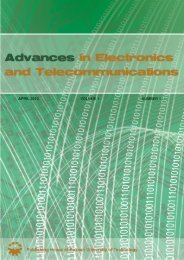november 2010 volume 1 number 2 - Advances in Electronics and ...
november 2010 volume 1 number 2 - Advances in Electronics and ...
november 2010 volume 1 number 2 - Advances in Electronics and ...
You also want an ePaper? Increase the reach of your titles
YUMPU automatically turns print PDFs into web optimized ePapers that Google loves.
22 ADVANCES IN ELECTRONICS AND TELECOMMUNICATIONS, VOL. 1, NO. 2, NOVEMBER <strong>2010</strong><br />
Krylov Subspace Methods <strong>in</strong> Application to<br />
WCDMA Network Optimization<br />
Abstract—Krylov subspace methods, which <strong>in</strong>clude, e.g. CG,<br />
CGS, Bi-CG, QMR or GMRES, are commonly applied as l<strong>in</strong>ear<br />
solvers for sparse large-scale l<strong>in</strong>ear least squares problems. In the<br />
paper, we discuss the usefulness of such methods to the optimization<br />
of WCDMA networks. We compare the selected methods<br />
with respect to their convergence properties <strong>and</strong> computational<br />
complexity, us<strong>in</strong>gatypical upl<strong>in</strong>kmodel for a WCDMA network.<br />
The comparison shows that GMRES is the most suitable method<br />
for our task.<br />
Index Terms—Krylov subspace methods, WCDMA network<br />
optimization, l<strong>in</strong>ear solvers, CG, GMRES<br />
Rafal Zdunek <strong>and</strong> Maciej Nawrocki<br />
I. INTRODUCTION<br />
OUR considerations are restricted to WCDMA network<br />
optimization at the stage of layout design. In this approach,the<br />
variablesof the cost functionare usually expressed<br />
<strong>in</strong> terms of transmitted powers that depend on the parameters<br />
to be optimized. The parameters basically concern base stations,<br />
i.e. their <strong>number</strong>, locations, antenna azimuth <strong>and</strong> tilt as<br />
well as pilot channel powers. The details on this are given <strong>in</strong><br />
[1]. Exclud<strong>in</strong>g very simplified models, the transmitted powers<br />
usually cannot be presented as analytical functions of the<br />
desired parameters.This implies the use of numerical methods<br />
for the computations of transmitted powers. Comput<strong>in</strong>g these<br />
powersis the most computationally<strong>in</strong>tensive task <strong>in</strong> an overall<br />
optimization problem, so f<strong>in</strong>d<strong>in</strong>g a proper (fast) method seems<br />
to be crucial. Assum<strong>in</strong>g the target Signal-to-Interference(SIR)<br />
valuesfor each l<strong>in</strong>k betweenaBase Station (BS) <strong>and</strong> a Mobile<br />
Station (MS), the transmitted powers can be computed from<br />
the system of l<strong>in</strong>ear equations:<br />
Ap = b, (1)<br />
where A =∈ IR K×K is the system matrix of coefficients that<br />
depend on the l<strong>in</strong>k ga<strong>in</strong>s, othogonality factors (for downl<strong>in</strong>k)<br />
<strong>and</strong> target SIR values, p ∈ IR K is the vector of unknown<br />
transmitted powers, b ∈ IR K is the noise vector. The aim<br />
is to f<strong>in</strong>d a possible best estimation of the vector p at the<br />
least computational cost. It should be noted that the task is<br />
very challeng<strong>in</strong>g s<strong>in</strong>ce the system (1) can be very large (even<br />
after apply<strong>in</strong>g the dimension reduction technique [2], [3]) <strong>and</strong><br />
such estimations must be repeated many times to provide<br />
many Monte Carlo (MC) samples used <strong>in</strong> static simulators<br />
for network plann<strong>in</strong>g <strong>and</strong> optimization [4], [5]. The system<br />
(1) has rather good numerical properties (square, consistent,<br />
R. Zdunek is with Institute of Telecommunications, Tele<strong>in</strong>formatics, <strong>and</strong><br />
Acoustics, Wroclaw University of Technology, 50–370 Wroclaw, Pol<strong>and</strong>, email:<br />
rafal.zdunek@pwr.wroc.pl<br />
M. Nawrocki is with OPTYME Consult<strong>in</strong>g, Wroclaw, Pol<strong>and</strong>, email:<br />
maciej.nawrocki@optyme.pl<br />
well-conditioned), <strong>and</strong> hence many l<strong>in</strong>ear solvers can be used<br />
<strong>in</strong> our application. Nevertheless, not all the methods have the<br />
same convergence properties <strong>and</strong> computational complexity,<br />
thus there is a need to study the usefulness of these methods<br />
to our task. The problem has been already tackled for <strong>in</strong><br />
our previous works [1], [6], [7], where we compared the<br />
Gaussian elim<strong>in</strong>ation <strong>and</strong> some iterative methods such as<br />
Jacobi, Gauss-Seidel, Successive Over-Relaxation (SOR), <strong>and</strong><br />
Conjugate Gradient Square (CGS). Some numerical results<br />
from [6], [7] will be rem<strong>in</strong>ded here. F<strong>in</strong>ally, we concluded<br />
<strong>in</strong> [6] that the Gauss-Seidel <strong>and</strong> CGS gave the best results.<br />
S<strong>in</strong>ce the CGS belongsto a class of Krylovsubspacemethods,<br />
we decided to cont<strong>in</strong>ue our tests with respect to the Krylov<br />
subspace methods which we shortly present <strong>in</strong> Section II. The<br />
comparison results are presented <strong>in</strong> Section III, <strong>and</strong> f<strong>in</strong>ally<br />
some conclud<strong>in</strong>g remarks are given <strong>in</strong> Section IV.<br />
II. KRYLOV SUBSPACE METHODS<br />
Krylov subspace methods are widely applied to solve largescale<br />
l<strong>in</strong>ear systems aris<strong>in</strong>g <strong>in</strong> many areas of science, especially<br />
to solve discretized Partial Differential Equations (PDE)<br />
[8], [9]. Due to their low computational cost, the methods can<br />
be also useful <strong>in</strong> the optimization of WCDMA networks. A<br />
short survey of the Krylov subspace methods that are used <strong>in</strong><br />
our experiments is given below.<br />
• CGLS<br />
Thefirst versionofthe ConjugateGradients(CG) method<br />
was proposed by Hestenes <strong>and</strong> Stiefel [10], <strong>and</strong> it is<br />
commonly used for solv<strong>in</strong>g symmetric l<strong>in</strong>ear systems. It<br />
iteratively m<strong>in</strong>imizesthe gradientof a quadraticobjective<br />
function with gradient updates derived from orthogonal<br />
directions. S<strong>in</strong>ce <strong>in</strong> our application the symmetry condition<br />
is not met, the CG method is applied to the normal<br />
equations. In the literature, such method is known as<br />
CGLS <strong>and</strong> it may be found <strong>in</strong> many implementations.<br />
We used the Hansen’s implementation [11].<br />
• CGS<br />
The Conjugate Gradient Square (CGS) method was <strong>in</strong>vented<br />
by Sonneveld [12] <strong>and</strong> it <strong>in</strong>volvesthe CG scheme.<br />
In contrary to the CG, it can be used to non-symmetric<br />
systems. Moreover, it is not sensitive to so-called the<br />
serious breakdown that may occur <strong>in</strong> the CG.<br />
• BiCG<br />
The Bi-Conjugate Gradient (BiCG) method, proposed<br />
by Fletcher [13], belongs to a group of bi-orthogonal<br />
methods <strong>and</strong> extends the st<strong>and</strong>ard CG method to nonsymmetric,<br />
large <strong>and</strong> sparse systems of l<strong>in</strong>ear equations.<br />
Hence, it may be suitable for our application.







